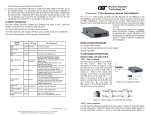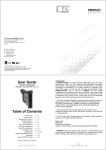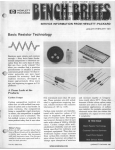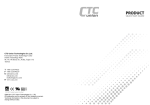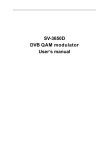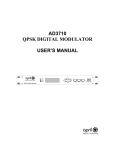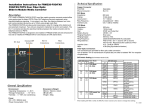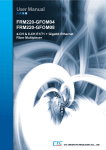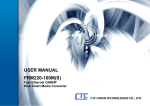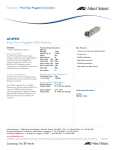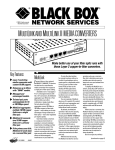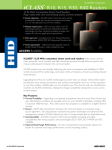Download User Guide Table of Contents
Transcript
CTC Union Technologies Co.,Ltd. Far Eastern Vienna Technology Center (Neihu Technology Park) 8F, No. 60 Zhouzi St., Neihu, Taipei 114, Taiwan T +886-2-26591021 F +886-2-26590237 E [email protected] [email protected] [email protected] H www.ctcu.com 2010 CTC Union Technologies Co., LTD. All trademarks are the property of their respective owners. Technical information in this document is subject to change without notice. User Guide 2.7G MultiRate 3R Transponder FRM220-2.7G-2S & FRM220-2.7G-3S Table of Contents Introduction Specifications Management Features Panel/Installation LED Indicators (2S) LED Indicators (3S) DIP Setting Loop Back Diagnostics Application – Extender/Protection Application - CWDM Console Management Upgrading About SFP Units ------- 1 ------- 2 ------- 2 ------- 3 ------- 4 ------- 5 ------- 6 ------- 7 ------- 8 ------- 9 ------- 10-12 ------- 13 ------- 13 Introduction The FRM220-2.7G-2S is a multi-rate, up to 2.7G 3R optical regeneration device with clock data recovery (CDR). The "3R" consists of Reamplification, Re-shaping and Re-timing. The transponder card converts a data signal to the correct wavelength for transmission on a specific channel by supporting SFP optics on both line side and client side interfaces. When the FRM220-2.7G-2S card is placed in the FRM220 rack with SNMP management, the management can view the converter card's status, type, version, fiber link status and alarms. The card can be configured to enable or disable the port, reset the port, provide client or line side diagnostic loopback, and set the desired data rate. The FRM220-2.7G-3S is a multi-rate, up to 2.7G 3R optical regeneration device with clock data recovery (CDR). The "3R" consists of Reamplification, Re-shaping and Re-timing. The transponder card converts a data signal to the correct wavelength for transmission on a specific channel by supporting SFP optics on both line side and client side interfaces. 1+1 Automatic optical line Protection Switching is supported for the aggregate fiber ports. When the FRM220-2.7G-3S card is placed in the FRM220 rack with SNMP management, the management can view the converter card's status, type, version, fiber link status and alarms. The card can be configured to enable or disable the port, reset the port, provide client or line side diagnostic look back, and set the desired data rate. The SFP sockets support a wide range of SFP modules to address any network situation. Single-mode Multi-mode Multi-rate Single fiber bi-directional Coarse and Dense Wave Division Multiplexing (CWDM and DWDM) Copper media WARNING: Fiber optic equipment may emit laser or infrared light that can injure your eyes. Never look into an optical fiber or connector port. Always assume that fiber optic cables are connected to a laser light source. Version 1.1 May 2010 -1w w w . C T C U . c o m w w w . C T C U . c o m Specifications Panel Optical Interface Connector Data rate Duplex mode Fiber Distance Wavelength 1+1 switch Indications Power Input Consumption Dimensions Weight Temperature Humidity Certification MTBF Test Loops Figure 1. Front Panel of FRM220-2.7G-2S and 3S SFP cage E3 (34.368Mb/s) to OC-48/STM-16 (2.48832Gbps) Full duplex Depends on SFP Depends on SFP Depends on SFP <50ms (3S model only) LED (PWR, Line Link, Client Link, Test, Loop back, Port Active, Alarm) (Card supports hot-swapping) Card : 12VDC, Standalone : AC, DC options <10W 155 x 88 x 23mm (D x W x H) 120g 0 ~ 50°C (Operating), -10 ~ 70°C (Storage) 10 ~ 90% non-condensing CE, FCC, LVD, RoHS 65000 hrs (25°C) Client Side LB (2S model) Line Side LB (2S model) Client & Line LBs (3S model) FRM220-2.7G-2S FRM220-2.7G-3S Installation Figure 2. Slide-in Card mounting of FRM220-2.7G-2S/3S Management Features Both models have an on-board 8 pole DIP Switch which can be used to configure the devices for stand-alone operation. When placed in a standalone chassis, these devices also support a text based serial terminal with an easy to use menu system for configuration. When placed in a managed chassis, the card is configured and monitored through the chassis NMC (network management controller) via console, Telnet, Web HTTP or SNMP. Note: Due to higher current requirements and excessive heat dissipation, this converter card can only be placed in the CH-02M, CH02-NMC or the full CH-20 chassis. CH02M Chassis AC, DC, 2AC, 2DC, or AD CH02-NMC Chassis AC, DC, 2AC, 2DC, or AD FRM220-CH20 Follow all ESD precautions when handling the card and SFP modules. -2- -3- w w w . C T C U . c o m w w w . C T C U . c o m LED Indicators (2S Model) LED Indicators (3S Model) LINE CLIENT LED PWR (Green) Link (Green) LBT (Green) Alarm (Red) Act (Green) Link (Green) LBT (Green) Alarm (Red) State On Flash Off On Off On Off On Off On Off On Off On Off On Off Status Power on During upgrade No Power Line Side Fiber link Line Side Fiber no link Line Loop Back Test Enabled Line Loop Back Test Off Tx Alarm from Line SFP No Line SFP Alarm Card is Active Card is disabled Client Side Fiber link Client Side Fiber no link Client Loop Back Test Enabled Client Loop Back Test Off Tx Alarm from Client SFP No Client SFP Alarm LED MGT (Green) Act (Green) PWR (Green) Online (Green) Online (Green) LBT (Green) Link (Green) Link (Green) Link (Green) Alarm (Red) Alarm (Red) Alarm (Red) State On Off On Off On Flash Off On Off On Off On Off On Off On Off On Off On Off On Off On Off Status In-rack management no rack management Card active Card disabled Power on During upgrade No Power Secondary Online Secondary Offline Primary Online Primary Offline Line Loop Back Test Enabled Line Loop Back Test Off Secondary Fiber link Secondary Fiber no link Primary Fiber link Primary Fiber no link Line Fiber link Line Fiber no link Tx Alarm from Secondary SFP No Secondary SFP Alarm Tx Alarm from Primary SFP No Primary SFP Alarm Tx Alarm from Line SFP No Line SFP Alarm -4- -5- w w w . C T C U . c o m w w w . C T C U . c o m DIP Settings Loop back Testing (LBT): DIP Switch On PCB The loopback capability of the FRM220-2.7G is useful for debugging a dysfunctional link, or when commissioning a site. In loopback mode, the signal is routed into the CDR circuitry and then routed back to the signal source. Loopback may be enabled via DIP switch selection or management terminal console. When placed in a managed FRM220-CH20 chassis, the loop back can be controlled by the NMC manager in FRM220 chassis. 2.7G-3S Only Dip Sw 2S 3S 1 Rate 1 Rate 1 2 Rate 2 Rate 2 3 Rate 3 Rate 3 4 Rate 4 Rate 4 2/3S Off On Off On Off On Off On Off On Off On Off Off On On Off Off On On Off Off On On Off Off Off Off On On On On Off Off Off Off Off Off Off Off Off Off Off off On On On On 5 6 LFP ALS LFP ALS Protocol Supported E3 DS3/T3 OC-1/STM-0 Fast Ethernet OC-3/STM-1 OC-12/STM-4 Fiber Channel-1 OC-24/STM-8 Gigabit Ethernet HD-SDI Fiber Channel-2 OC-48/STM-16 2.7G-2S Fiber Loop Back 7 8 X X Protect Client Fiber Data Rate 34.368Mbps 44.736Mbps 51.84Mbps 125Mbps 155.52Mbps 622.08Mbps 1.0625Gbps 1.24416Gbps 1.25Gbps 1.485Gbps 2.125Gbps 2.48832Gbps Sw5 LFP Off=Link Fault Pass-thru disabled; On=enabled Sw6 ALS Off=Auto Laser Shutdown disabled; On=enabled Sw7 Forced (3S Only) Off=Manual (Forced) Protection; On=Automatic Protection* * when On, Sw8 is not followed Sw8 Path (3S Only) Off=Client is on Primary; On=Client is on Secondary** ** works only when Sw7 is Off for manual forced setting Client Loop Back Line Loop Back The FRM220-2.7G-2S model features a front panel mounted 2-pole DIP switch. This switch enabled loop back for either client or line fibers. The upper switch, when turned on, enables the Line side fiber loop back. The lower switch, when turned on, enables the Client side fiber loop back. The loop back function can also be enabled by using a serial terminal connected to the 9 pin D-Sub on the CH02M, via the terminal menu system. If placed in FRM220-CH20 with NMC/SNMP, the chassis management system can access the card and perform all setting functions. (The front panel switches will be ignored and overridden by NMC manager.) The FRM220-2.7G-3S model can only do loop back through one of the management interfaces i.e. local console or NMC. The loop back function is enabled by using a serial terminal connected to the 9 pin D-Sub on the CH02M, via the terminal menu system. If placed in FRM220-CH20 with NMC/SNMP, the chassis management system can access the card and perform all setting functions. (The internal DIP switch settings will be ignored and overridden by NMC manager.) Notice: All of these settings are ignored if the card is placed in the FRM220-CH20 with NMC/SNMP management. The card will follow the settings done via the chassis management. -6- -7- w w w . C T C U . c o m w w w . C T C U . c o m The FRM220-2.7G 3R repeater works in point-to-point applications, either as a stand-alone or when placed in the FRM220-CH20 managed rack. CWDM Transponder The FRM220-2.7G functions primarily as a repeater or a media converter. As a repeater for long-haul applications, the signal is fully regenerated at the trunk. Clock Data Recovery (CDR) helps in reshaping, retiming, and regenerating (3R) the output signal at a number of pre-assigned frequencies or protocols. In the CWDM/DWDM application, the 3R transponder acts as a fiber-tofiber repeater and optical frequency converter between the client side equipment and the Optical Multiplexer/De-multiplexer. Application Extension Repeater 2S 2S Client Client Line Line Set local and remote 3R repeater to the protocol's data rate either by local DIP or through management. The rate setting is the only setting required. Protection The FRM220-2.7G-3S has the ability to provide 1+1, non-revertive redundancy protection for single input, repeater/media converter applications complete with full 3R capabilities on each trunk. This first application of protection is line side protection. In this setup, the line connector actually faces the client. 3S Client 3S PRI FRM220-CH20 20-slot chassis Client 1310 SFP Line 1470 SFP 1470 Line 1490 SFP 1490 Line 1510 SFP 1510 Line 1530 SFP 1530 Client 1310 SFP Client Client 1550 SFP LINE SEC Mux/Demux WAN PRI LINE 2S SEC The second application provides for redundant clients and automatic fall over. 3S 2S PRI CLIENT Client 850 SFP Client Redundant Clients LINE LINE SEC Set transponder to the protocol's data rate either by local DIP or through management. The rate setting is the only setting required. -8- -9- w w w . C T C U . c o m w w w . C T C U . c o m Console Management When placed in the 2-slot CH02M chassis, this card can be locally managed by connecting a simple serial terminal such as a notebook computer that has an RS232 port or via a commonly available USB to RS232 adapter. In Windows XP, HyperTerminal™ is an application available for emulating a serial terminal. You can also search for TeraTerm or PuTTY which are free alternatives, especially if the operating system is Vista or Win7. Settings Baud Rate: 38,400 Data bits: 8 Parity bits: none Stop bits: 1 Handshaking: none Emulation: VT-100 Connect the serial cable to the CH02M's DB9. Run the terminal emulation program. With power on, press [ESC], [space] or [Enter] to display the "Main Menu" screen. The following is an example. **************************************** *** CTC UNION TECHNOLOGIES CO.,LTD *** *** FRM220 2.7G-2S Manager Ver:1.00 *** **************************************** Version:[1.100-1.000-1.100-0.000] [CH-02M Slot-1 Line Status[Down] Client Status[Down] <1> Port Active: [Enable ] <2> Baud Rate Select: [Fast Ethernet <3> Line Side Loopback Test: [Off ] <4> Client Side Loopback Test: [Off ] <5> Link Fault Pass-Through: [Disable] <6> Line Side Auto Laser Shutdown: [Disable] <7> Client Side Auto Laser Shutdown: [Disable] <D> D/D Function <R> Port Reset <S> Store Parameters Please select an item. Operation Select any of the menu items by keying in the menu item number or letter. Use the [ESC] to return to a previous menu. Any setting is immediately applied to the transponder's circuitry. After all of the parameter settings have been selected, press "s" from the main menu to save the parameters in non-volatile RAM (NVR). To revert to previous settings before saving, press "r" to reset (reload previously saved parameters). Explanation of Settings 1. Port Active: This will enable or disable the card. When inactive, no transmissions will be able to occur. 2. Baud Rate Select: This will bring up the data rate selection list. Select the required 3R recovery speed by choosing the protocol. 3. Line Side LBT: This will activate the Line side loop back diagnostics 4. Client Side LBT: This will activate Client side fiber loop back diagnostics 5. LFP: Enables or Disables Link Fault Pass Through function 6. Line ALS: This can enable Auto Laser Shutdown protection for Line side 7. Client ALS: Can enable Client side Auto Laser Shutdown protection D. D/D: Enables user to read the serial data stored in SFP module R. Reset: This will cause the parameters settings in NVR to be reloaded S. Store: Saves the setting parameters into non-volatile RAM (NVR) Example of reading Digital Diagnostics in SFP ] ] Example of Main Menu Console Screen, FRM220-2.7G-2S D/D Function: <1> Line Side D/D Function: [Yes ] <2> Client Side D/D Function: [Yes ] <ESC> Go to previous menu. Please select an item. ------------------------------------------------------------Client Side D/D Function: Vendor Name :[FIBERXON INC. ] Vendor Part Number :[FTM-6128C-L5051 ] Fiber Type :[Single ] Tx Wave Length :[1510 nm ] RX Wave Length :[1510 nm ] Link Length :[0050 Km ] Tx Power :[ -01 dBm] Rx Power :[ -41 dBm] Rx Sensitivity :[ 00 dBm] Temperature :[ 42 C ] <ESC> Go to previous menu. Parameters are read from any MSA compliant SFP module. Extended information is only available in modules which support D/D function. - 10 - - 11 - w w w . C T C U . c o m w w w . C T C U . c o m Repeater with Protection There are additional menu items for the FRM220-2.7G-3S model to control the behavior of the Pri. and Sec. fiber 1+1 behavior. Upgrading The FRM220-2.7G card may be firmware upgraded when it is placed in the FRM220 with NMC management card. The user may use a local console connection to the NMC, a remote Telnet (IP) connection, or a Web based (HTTP) connection with any available browser. The NMC communicates to all cards through a serial RS485 control bus. The upgrade code is transferred to the NMC by way of TFTP server. All of these mentioned upgrade methods are well documented in the FRM220-NMC Software Operation Manual. Explanation of Settings 1. Port Active: This will enable or disable the card 2. Baud Rate Select: This will bring up the protocol rate selection list 3. Fiber Protection: When set off, the fiber path is manually selected through item 4's selection. When set on, the fiber will automatically take the redundant path if working path fails (non-revertive) 4. Select Client Path: When item 3's protection is set to manual (off), this setting will force the client's path as either 'Primary' or 'Secondary' 5. LBT: This will enable simultaneous Line and Client fiber loop back 6. LFP: Enables the Link Fault Pass Through action 7. Line ALS: This can enable/disable Auto Laser Shutdown for Line side 8. Primary ALS: Can enable/disable Primary side Auto Laser Shutdown 9. Secondary ALS: Can enable/disable Secondary side Auto Laser Shutdown D. D/D: Enables user to read the serial data stored in SFP module R. Reset: This will cause the parameters settings in NVR to be reloaded S. Store: Saves the setting parameters into non-volatile RAM (NVR) **************************************** *** CTC UNION TECHNOLOGIES CO.,LTD *** *** FRM220 2.7G-3S Manager Ver:1.00 *** **************************************** Version:[1.100-1.000-1.100-0.000] [CH-02M Slot-1 ] Line Status[Down] Primary Status[Down] Secondary Status[Down] <1> Port Active: [Disable] <2> Baud Rate Select: [Fast Ethernet ] <3> Optic Fiber Protection: [Off ] <4> Select Client Master: [Primary ] <5> Loopback Test Function: [Off ] <6> Link Fault Pass-Through: [Disable] <7> Line Side Auto Laser Shutdown: [Disable] <8> Primary Side Auto Laser Shutdown: [Disable] <9> Secondary Side Auto Laser Shutdown: [Disable] <D> D/D Function <R> Port Reset <S> Store Parameters Please select an item. About SFP Units The FRM220-2.7G accepts any SFP unit that complies with the MSA standard. Follow all ESD precautions when handling the card and SFP modules. Fiber optic components and cables are very sensitive to dirt, dust and mishandling, especially in high-speed networks. Dirty or mistreated fiber may cause errors and an unwanted degradation of signal quality. Remove the dust caps on SFP only when ready to plug in optical cables. When choosing SFP optical modules, the SFP must be able to support the required data rate. OC3 SFP (155M) will operate fine at STM-1 and Fast Ethernet speeds, but not all modules will operate at lower speeds (E3, T3, or STM-0). Make sure the SFP modules chosen are suitable for the required data rate. Installation CTC Union supplied SFP modules are of the Bale Clasp type. The bale clasp SFP module has a bale clasp that secures the module into the SFP cage. • Inserting a Bale Clasp SFP Module into a SFP cage Step 1 Close the bale clasp upward before inserting the SFP module. Step 2 Line up the SFP module with the port, and slide it into the cage. • Removing a Bale Clasp SFP Module Step 1 Open the bale clasp on the SFP module. Press the clasp downward with your index finger. Step 2 Grasp the SFP module between your thumb and index finger and carefully remove it from the SFP cage. Example of Main Menu Console Screen, FRM220-2.7G-3S - 12 - - 13 - w w w . C T C U . c o m w w w . C T C U . c o m




